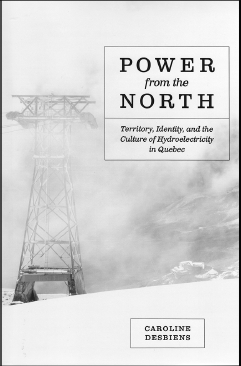Corps de l’article
Across the twentieth and into the twenty-first century, North American Indian lands have been subject to large-scale economic invasion as energy colonies by Euro-American society. Prominent examples include construction of the Grand Coulee Dam on the Columbia River in the 1930s, postwar coal and uranium mining on the Navaho Reservation in the American Southwest, and, in Canada, Quebec’s James Bay Hydroelectric Project. Famously launched by the Bourassa Government in 1971 as ‘le projet du siècle’, the James Bay Project has drawn voluminous commentary by scholars, journalists, and activists ever since.
Most of the scholarship – by ethnologists/anthropologists Toby Morantz, Harvey Feit, Adrian Tanner and others – has focused on the consequences for the James Bay Cree. Historical geographer Desbiens’ Power from the North joins an emerging body of work by Francophone researchers (including literature scholar Dominique Perron and historian Stéphane Savard) who employ the tools of literary criticism and cultural history to unpack the debate and discourse around postwar hydroelectric projects carried out by the Quebec state via its development agent Hydro-Québec. In Desbiens’ case, the author traces the “cultural construction of James Bay” (10) by Québécois politicians and public relations officers during Phase 1 of the La Grande River project as a terrain of pioneering and heroic conquest. Such rhetoric, she asserts, was not merely “the fantasy (and fallacy) of many southerners” (215), devoid of the Crees’ experiential and intimate knowledge of the land, but was also the underlying narrative of Quebec’s larger project of “colonial” (207, 209, etc.) expansion into Nouveau Québec during and after the Quiet Revolution.
This is not entirely new news. Most of those who have followed the events of the James Bay Project will be aware of its early heroic discourse and have considered its colonial character. The originality of the book, in my view, is threefold. First, Desbiens reminds us that Quebec’s occupation of the North was not merely a matter of mapping (Canadian law extended Quebec’s boundary northward to Hudson Strait in 1912), or of implanting infrastructure, whether roads, dams and transmission lines; it was also a matter of myth making. In short, “the culture of hydroelectricity” (as in the book’s title) mattered too. As she puts it: “Southern Quebec’s claim to the entirety of the provincial peninsula largely rests on a merging of Québécois cultural identity with the territory….[H]ydroelectric development opened the way to a rescaling of the Québécois nation ….” (209-10).
Second, Desbiens has written a book in English (published as part of the Nature/History/Society series of UBC Press), which is aimed at an Anglophone audience that may never have heard of the La Grande River, let alone know basic facts of Quebec history. At numerous points in the text, she is careful to translate and explicate the language she cites, beginning with the Liberal’s “maîtres chez nous” slogan of 1962. Regarding the lyrics of George Dor’s “La Manic”, for example, she writes: “In French, the verb s’ennuyer connotes boredom but also loneliness and the general feeling of missing someone” (36).
Third, Desbiens has placed herself squarely in the text, weaving into the book her own personal exposure to the James Bay Project as a youth, starting with a child’s awe at seeing a giant piece of construction equipment trucked through her Montreal suburb. In this way, she eschews the pretense of scientific objectivity, instead acknowledging the presence of the human being who is also a French-Canadian citizen, behind the scholar. In this way, too, Desbiens offers something of an insiders’ tale to the English-speaking reader.
What might have been an additional element of originality, in which Desbiens locates the roots of James Bay’s heroic narrative in the literary genre known as the roman de la terre, I find less sure-footed. Drawing on such works as Ringuet’s Trente arpents and Groulx’s L’Appel de la race, Desbiens suggests that it was the land-based, clerical, territorial nationalism of the “conquête du sol” – underlying the colonization movement of the late nineteenth through early twentieth centuries – that shaped and coloured the secular, statist, economic nationalism of postwar big hydro. Yes, both link land to French-Canadian survivance; as she puts it, “nature and territory have anchored identity from the roman de la terre to James Bay.” (119). But the historian wants an analysis as to why the rural novel has been chosen over other available sources, whether political speeches, surveyors’ reports, commercial advertisements, or newspaper editorials. Yet we could just as well locate the rhetoric of 1970s’ dam-building in the early twentieth century Liberal Party assertions in the eras of Lomer Gouin and L.A. Taschereau: that the large-scale exploitation of Quebec’s forestry, mining and hydro resources was key to the cultural survival of French-Canadian people.
This aside, Power from the North makes a thought-provoking and self-reflective contribution to the literature on the James Bay Project.



